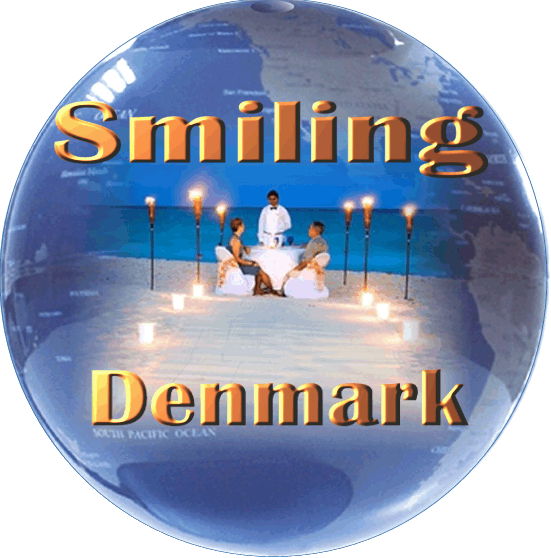
Visit Copenhagen Hotels Copenhagen Best Restaurants Copenhagen
The happiest people on earth
And
the best Michelin restaurant in the world
Velcome
to SmilingGlobe.com - Visit Copenhagen Denmark
Smilingglobe.com presents all countries (this is
Smiling Denmark by Visit Copenhagen Denmark)
Smiling Denmark
It’s official: Denmark
is the world’s most contented country. The diminutive nation tops most
happiness studies with Scandinavian reliability. It’s easy to see why:
standards of living are sky-high. Transport runs on time; summer houses on
the beach are the norm (there’s an abundance of sandy shores); cycle
paths thread through the cities, forests, dales and wetlands; restaurants
in Denmark serve up some of world’s best (and freshest) grub.
Cafe-cruise in laid-back Copenhagen,
Copenhagen
restaurant Noma
has been named the best restaurant in the world. Book
your table at Noma. canoe the fjords of North
Jutland or hire a bike to tackle the 11 national cycle routes, and
find out what they’re smiling about.
June to August boasts good weather and many open-air festivals;
Roskilde (www.roskilde-festival.dk), the biggest, is in early July.
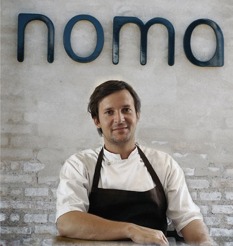 Restaurants
behind the crowning of restaurant Noma in the past year has been very
successful to specialize in Nordic cuisine.
Restaurants
behind the crowning of restaurant Noma in the past year has been very
successful to specialize in Nordic cuisine.
Our intention at Restaorant noma is to create and to prepare a distinctly advanced kind of cuisine, while nonetheless conjoining our patently Nordic approach with a manner of purity and simplicity in the approach. We are also busy infusing our new Nordic cuisine with a markedly curative potential. These values are all reflected in our menus’ ultimate articulation and manifest themselves both in the construction and presentation of the individual courses and in the means of preparation and ingredients upon which they are based. Book your table
Copenhagen is still Scandinavia s gastronomic capital, with the best restaurants.
The Michelin Guide in 2010 have 12 restaurants in Copenhagen together 13 Michelin stars.
Restaurant AOC is new to the list. Nordic food best international
The past decade,
the Nordic kitchen experienced a comeback of the very big thanks to
Copenhagen s top restaurants.
With a focus on pure Danish and Nordic ingredients and innovative cuisine
has been the city s restaurateurs international gourmet writers and critics
to turn the spotlight towards Copenhagen. Book
your table at noma
One of the restaurateurs are René Redzepi, whose restaurant Noma has
retained its two stars in the Michelin Guide 2010th, and is now the worlds
best restaurant.
Introducing Smiling Denmark
/Par_i_Tivoli.jpg) The
Danes are, overwhelmingly, a happy bunch. In fact, if you believe those
contentment surveys that come out every couple of years,
The
Danes are, overwhelmingly, a happy bunch. In fact, if you believe those
contentment surveys that come out every couple of years, Denmark is one of the happiest nations on earth with some of the best
quality of life. Along winding cobbled streets Danes shop and dine at some
of the most exciting places in Europe.
Copenhagen’s
restaurants have more Michelin stars than any other Scandinavian city, and
Denmark as a whole would doubtless have more still if the inspectors from
Michelin ever troubled themselves to leave the capital and head for Aalborg
or Århus
& around. Even standards in a workaday Danish café are generally
very high. - - And of course, in Copenhagen, you'll find "Noma",
the world's best Michelin star restaurant.
Denmark is one of the happiest nations on earth with some of the best
quality of life. Along winding cobbled streets Danes shop and dine at some
of the most exciting places in Europe.
Copenhagen’s
restaurants have more Michelin stars than any other Scandinavian city, and
Denmark as a whole would doubtless have more still if the inspectors from
Michelin ever troubled themselves to leave the capital and head for Aalborg
or Århus
& around. Even standards in a workaday Danish café are generally
very high. - - And of course, in Copenhagen, you'll find "Noma",
the world's best Michelin star restaurant.
Beyond the capital and the bigger cities, Smiling
Denmark
offers a mix of lively towns such as Ribe
and Odense
plus rural countryside, medieval 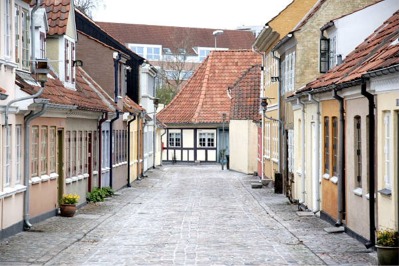 churches,
Renaissance castles and tidy 18th-century villages. Neolithic dolmen,
preserved 2000-year-old ‘bog people’, and impressive Viking ruins are
just some of the remnants of the nation’s long and fascinating history.
churches,
Renaissance castles and tidy 18th-century villages. Neolithic dolmen,
preserved 2000-year-old ‘bog people’, and impressive Viking ruins are
just some of the remnants of the nation’s long and fascinating history.
Denmark continues to stamp its effortlessly cool style on the world with its furniture, fashion, architecture and graphic design, as it has done for the last half-century or so. This obsession with good design, detail and fine craftsmanship is evident even in something as mundane as a Copenhagen metro or train ride.
Centuries on from the Viking era, Denmark remains very much a maritime nation, bordered by the Baltic and the North Sea. No place in the country is more than an hour’s drive from its lovely seashore, much of which is lined with splendid white-sand beaches.
Denmark’s hydrocarbon-rich economy is booming; it has the highest per capita GDP in the European Union (EU); literacy is 100%; unemployment is low; and its social-welfare programmes are the envy of continents. Education is free, and about half of all Danish students who graduate from secondary school continue on to higher education.
 You
don’t need statistics to understand the Smiling Dane’s happy lot, though.
Stroll around Copenhagen
or pretty much any Danish town and you’ll experience some of the most
harmonious civic spaces anywhere. The capital’s intimate scale and
faultless transport systems combine with the ornate history and bold
modern lines of the built environment to delight the eye, while the
locals’ courtesy and sense of humour is refreshing.
You
don’t need statistics to understand the Smiling Dane’s happy lot, though.
Stroll around Copenhagen
or pretty much any Danish town and you’ll experience some of the most
harmonious civic spaces anywhere. The capital’s intimate scale and
faultless transport systems combine with the ornate history and bold
modern lines of the built environment to delight the eye, while the
locals’ courtesy and sense of humour is refreshing.
It’s hard, in short, to find fault with the place. The visitor’s most heartfelt grumble is usually the cost of visiting Denmark. True, it is not a cheap destination, but no more so than the UK, and which nation’s public transport system would you rather use?
Cheer yourself up by thinking of the country’s peerless organisation and clockwork railway timetable as being subsidised by the extremely high taxes paid by your hosts. When viewed in this way, this first-rate destination seems like good value, and you get the fairy tales thrown in for free: the Danish royal family is genuinely loved and respected by the vast majority of its citizens, not least handsome Prince Frederik, his beautiful Australian-born princess-bride, Mary, and their young family.
If you love castles
If you love castles, Denmark has almost as many
fairy tale castles as it does fairy tales! Visit the picturesque region of
North Zealand just outside Copenhagen where you will find Elsinore
and Kronborg
Castle made famous as the setting of Shakepspeare
s Hamlet as well as the 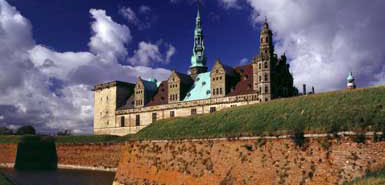 magnificent
Fredensborg Palace and Frederiksborg Castle.
magnificent
Fredensborg Palace and Frederiksborg Castle.
Leave Copenhagen behind as you head north through
magnificent Danish countryside and coastline towards Elsinore
and Kronborg
Castle. Chosen as the setting for Shakespeare s Hamlet, this
magnificent renaissance castle is on the UNESCO world heritage list.
After lunch (own expense), your tour continues towards Fredensborg, where
the Queen s summer residence of Fredensborg Palace is attractively located
in the middle of a lovely park, bordering the idyllic Esrum Lake.
The next highlight on your tour is Frederiksborg Castle, built by King
Christian IV in 1601 - 1625. This pearl of history, built in magnificent
Renaissance style with a touch of baroque, is now a national historical
museum, containing treasures of painting, tapestry, porcelain, silver and
furniture.
Tivoli is the pride and joy of Copenhagen. For over 250 years people have been flocking here to enjoy the various amusement rides and
 games. Children will be delighted with the merry-go-round where Viking ships take the place of the standard horses and other animals. No matter what day of the week, there always seems to be some sort of musical event taking place at the
Tivoli whether
it's a rock concert or a parade. The Arabian-style fantasy palace houses numerous restaurants in addition to a beer garden. The opulent gardens are bursting with color as tulips are everywhere one looks. During the evening hours the scenery is just as amazing with over 100,000 Chinese colored lanterns lighting up the Chinese pagoda and main fountain. On many evenings brilliant fireworks light up the sky. Copenhagen is also renowned for its many fine dining and shopping establishments. After a delicious Danish meal, tourists can head out to any of the numerous jazz clubs or opt to dance the night away under the stars at any of the
city's happening night spots.
games. Children will be delighted with the merry-go-round where Viking ships take the place of the standard horses and other animals. No matter what day of the week, there always seems to be some sort of musical event taking place at the
Tivoli whether
it's a rock concert or a parade. The Arabian-style fantasy palace houses numerous restaurants in addition to a beer garden. The opulent gardens are bursting with color as tulips are everywhere one looks. During the evening hours the scenery is just as amazing with over 100,000 Chinese colored lanterns lighting up the Chinese pagoda and main fountain. On many evenings brilliant fireworks light up the sky. Copenhagen is also renowned for its many fine dining and shopping establishments. After a delicious Danish meal, tourists can head out to any of the numerous jazz clubs or opt to dance the night away under the stars at any of the
city's happening night spots.
Greater Copenhagen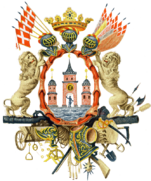
The conurbation of Copenhagen consists of several municipalities. After Copenhagen Municipality, the second largest is Frederiksberg Municipality which is an enclave inside Copenhagen Municipality. Both are contained in the larger Capital Region of
Denmark, containing most of the Copenhagen metropolitan area.
Previously, the areas of Frederiksberg, Gentofte and Copenhagen municipalities have been used to define the city of Copenhagen. This definition is now obsolete. To meet statistical needs upon the latest municipal reform, which took place in the beginning of 2007, a definitory concept of Danish lands (Danish:
Landsdele) have been introduced.. A land is basically a geographical and statistical definition, and the area is not considered to be an administrative unit. The land of Copenhagen City includes the municipalities of Copenhagen, Dragør, Frederiksberg and Tårnby, with a total population of 667,228 in the beginning of 2009.
Copenhagen and Frederiksberg were two of the three last Danish municipalities not belonging to a county. On the 1st of January 2007, the municipalities lost their county privileges and became part of Copenhagen Capital Region.
Architecture
 The oldest section of Copenhagen s inner city is often referred to as "Middelalderbyen" (The Medieval City). However, the most distinctive district of Copenhagen is Frederiksstaden developed during the reign of Frederick V. It has Amalienborg Palace at its centre and is dominated by the dome of the Marble Church as well as a number of elegant 18th century mansions. Also part of the old inner city of Copenhagen is the small island of Slotsholmen with Christiansborg Palace and Christianshavn. Around the historical city centre lies a band of congenial residential bouroughs (Vesterbro, Inner Nørrebro, Inner Østerbro) dating mainly from late 19th century. They were built outside the old ramparts of the city when the city was finally allowed to expand beyond this barrier.
The oldest section of Copenhagen s inner city is often referred to as "Middelalderbyen" (The Medieval City). However, the most distinctive district of Copenhagen is Frederiksstaden developed during the reign of Frederick V. It has Amalienborg Palace at its centre and is dominated by the dome of the Marble Church as well as a number of elegant 18th century mansions. Also part of the old inner city of Copenhagen is the small island of Slotsholmen with Christiansborg Palace and Christianshavn. Around the historical city centre lies a band of congenial residential bouroughs (Vesterbro, Inner Nørrebro, Inner Østerbro) dating mainly from late 19th century. They were built outside the old ramparts of the city when the city was finally allowed to expand beyond this barrier.
Sometimes referred to as "the City of Spires", Copenhagen is known for its horizontal skyline, only broken by spires at churches and castles. Most characteristic is the baroque spire of Church of Our Saviour with its spiralling and narrowing external stairs that visitors can climb to the very top of the spire. Other important spires are those of Christiansborg Palace, the City Hall and the former Church of St. Nikolaj that now houses a modern art venue. A bit lower are the renaissance spires of Rosenborg Castle and the "dragon spire" of Christian IV s former stock exchange, so named because it is shaped as the tails of four dragons twined together.
Recent years have seen a tremendous boom in modern architecture in Copenhagen both when it comes to Danish architecture and works by international architects. For a few hundred years, virtually no foreign architects had worked in Copenhagen but since the turn of the millennium the city and its immediate sourroundings have seen buildings and projects from international star architects. In the same time, a number of Danish architects have achieved great success both in Copenhagen and abroad. Buildings in Copenhagen have won RIBA European Awards four years in a row ("Sampension" in 2005, "Kilen" in 2006, "Tietgenkollegiet" in 2007 and the Royal Playhouse in 2008). At the 2008 World Architecture Festival in Barcelona, Bjarke Ingels Group won an award for the World s Best Residential Building 2008 for a house in Ørestad. The Forum AID Award for Best building in Scandinavia went to Copenhagen buildings both in 2006 and 2008. In 2008 British design magazine Monocle named Copenhagen the World s best design city 2008.
The boom in urban development and modern architecture means that the above mentioned horizontal skyline has seen some changes. A political majority has decided to keep the historical centre free of highrises. But several areas will see or have already seen massive urban development. Ørestad is the area that until now has seen most of the development. Located near Copenhagen Airport, it currently boasts one of the largest malls in Scandinavia and a variety of office and residential buildings as well as an IT University and a high school. The two largest hotels in Scandinavia are currently under construction (ultimo 2008).
An ambitious regeneration project will create a new Carlsberg District at the historical premises of the Carlsberg Breweries that has terminated the production of beer in Copenhagen and moved it to Fredericia. The district will have a total of nine highrises and seeks to mix the old industrial buildings with modern architecture to create a dense, maze-like quarter with a focus on sustainability and an active urban life. A third major area of urban development also with a focus on sustanibility is Nordhavn. The Copenhagen tradition with urban development on artificial islands that was initiated with Christian IV s construction of Christianshavn has recently been continued with the creation of Havneholmen as well as a canal district at Sluseholmen in the South Harbour. A district in Copenhagen with a very different take on modern architecture is that of Christiania whose many creative and idiosyncratic buildings are exponents of an "architecture without architects".
has terminated the production of beer in Copenhagen and moved it to Fredericia. The district will have a total of nine highrises and seeks to mix the old industrial buildings with modern architecture to create a dense, maze-like quarter with a focus on sustainability and an active urban life. A third major area of urban development also with a focus on sustanibility is Nordhavn. The Copenhagen tradition with urban development on artificial islands that was initiated with Christian IV s construction of Christianshavn has recently been continued with the creation of Havneholmen as well as a canal district at Sluseholmen in the South Harbour. A district in Copenhagen with a very different take on modern architecture is that of Christiania whose many creative and idiosyncratic buildings are exponents of an "architecture without architects".
Visit Copenhagen Concert Hall

Copenhagen has a significant jazz scene that has existed for many years. It developed when a number of American jazz musicians such as Ben Webster, Thad Jones, Richard Boone, Ernie Wilkins, Kenny Drew, Ed Thigpen, Bob Rockwell, Dexter Gordon, and others such as rock guitarist Link Wray came to live in Copenhagen during the 1960s. Every year in early July Copenhagen s streets, squares and parks fill up with big and small jazz concerts during the Copenhagen Jazz Festival (see yearly events). The most important venue for rhythmical music in Copenhagen is Vega in Vesterbro district which has been chosen as "best concert venue in Europe" by international music magazine Live
For free entertainment one can stroll along Strøget, especially between Nytorv and Højbro Plads, which in the late afternoon and evening is a bit like an impromptu three-ring circus with musicians, magicians, jugglers and other street performers.
Copenhagen is a major regional center of culture, business, media, and science. In 2008 Copenhagen was ranked #4 by Financial Times-owned FDi magazine on their list of Top50 European Cities of the Future after London, Paris and Berlin. In the 2008 Worldwide Centers of Commerce Index, published by MasterCard, Copenhagen was ranked 14th in the world and 1st in Scandinavia. In the The 2008 Global Cities Index, Copenhagen was ranked 36th in the world, 15th in Europe, and 2nd in Scandinavia. Life science, information technology and shipping are important sectors and research & development plays a major role in the city’s economy. Its strategic location and excellent infrastructure with the largest airport in Scandinavia located 14 minutes by train from the city centre, has made it a regional hub and a popular location for regional headquarters as well as conventions. With around 2.7 million inhabitants within a 50 km radius, Copenhagen is one of the most densely populated areas in Northern Europe. Copenhagen region ranks 3rd in Western Europe and 1st in the Nordic countries for attracting head offices.
Copenhagen has repeatedly been recognized as one of the cities with the best quality of life and in 2008 it was singled out as the Most Liveable City in the World by international lifestyle magazine Monocle on their Top 25 Most Liveable Cities 2008 list. It is also considered one of the world’s most environmentally friendly cities with the water in the inner harbor being so clean that it can be used for swimming and 36% of all citizens commuting to work by bicycle, every day bicycling a total of 1.1 million km. Since the turn of the millennium Copenhagen has seen a strong urban and cultural development and has been described as a boom town. This is partly due to massive investments in cultural facilities as well as infrastructure and a new wave of successful designers, chefs and architects. Travellers have voted Copenhagen the cleanest city in Europe.
From its humble origins as a fishing village to its heyday as the glittering capital of the Danish Empire, to its current position as one of the world’s premier design capitals, the stories and characters of Copenhagen’s history can be discovered in its sumptuous palaces, copper-roofed town houses and atmospheric cobbled squares. From the Viking Age there was a fishing village by the name of “Havn” (harbour) at the site. Recent archeological finds indicate that by the 11th century, Copenhagen had already grown into a small town with a large estate, a church, a market, at least two wells and many smaller habitations spread over a fairly wide area.[20] Many historians believes that the town dates back to the late Viking ages and possible founded by Sweyn I Forkbeard. From the middle of the 12th century it grew in importance after coming into the possession of the Bishop Absalon, who fortified it in 1167, the year traditionally marking the foundation of Copenhagen. The excellent harbour encouraged Copenhagen’s growth until it became an important centre of commerce.
The city’s origin as a harbour and a place of commerce is reflected in its name. Its original designation, from which the contemporary Danish name is derived, was Køpmannæhafn, “merchants’ harbour”. The English name for the city is derived from its Low German name, Kopenhagen. The element hafnium is also named for Copenhagen, whose Latin name is Hafnia.
It was repeatedly attacked by the Hanseatic League as the Germans took notice. In 1254, it received its charter as a city under Bishop Jakob Erlandsen. During 1658-59 it withstood a severe siege by the Swedes under Charles X and successfully repelled a major assault. In 1801 a British fleet under Admiral Parker fought a major battle, the Battle of Copenhagen, with the Danish Navy in Copenhagen harbour. It was during this battle Lord Nelson famously “put the telescope to the blind eye” in order not to see Admiral Parker’s signal to cease fire.
When a British expeditionary force bombarded Copenhagen in 1807, to gain control of the Danish Navy, the city suffered great damage and hundreds of people were killed. The reason why the devastation was so great was that Copenhagen relied on an old defence-line rendered virtually useless by the increase in shooting range available to the British. But not until the 1850s were the ramparts of the city opened to allow new housing to be built around The Lakes (Danish: Søerne) which bordered the old defence system to the west. This dramatic increase of space was long overdue, not only because the old ramparts were out of date as a defence system, but also because of bad sanitation in the old city. Before the opening, Copenhagen Center was inhabited by approximately 125,000 people, peaking in the census of 1870 (140,000); today the figure is around 25,000. In 1901, Copenhagen expanded further, incorporating communities with 40,000 people, and in the process making Frederiksberg an enclave within Copenhagen.
During World War II, Copenhagen was occupied by German troops along with the rest of the country from 9 April 1940 until 4 May 1945. In August 1943, when the government’s collaboration with the occupation forces collapsed, several ships were sunk in Copenhagen Harbour by the Royal Danish Navy to prevent them being used by the Germans. The city has grown greatly since the war, in the seventies using the so-called five-finger-plan of commuter train lines to surrounding towns and suburbs.
Since the summer 2000, the cities of Copenhagen and Malmö have been connected by a toll bridge/tunnel (Øresund Bridge), which allows both rail and road passengers to cross. As a result, Copenhagen has become the centre of a larger metropolitan area which spans both nations. The construction of the bridge has led to a large number of changes to the public transportation system and the extensive redevelopment of Amager, south of the main city.
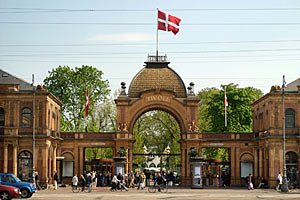
Copenhagen s Tivoli Gardens -- an amusement park,
restaurant Mecca, and cultural hot spot all tied up together in one
package -- is the city's marquee attraction. And for good reason.
It's magical.
The 160-plus-year-old park is not only an icon of history but also the
place that inspired local -- and equally legendary -- writer Hans
Christian Andersen to write "The Nightingale." It also inspired
an even more significant revolutionary: It is said that Walt Disney got
the idea to build Disneyland, his first amusement park, after visiting
Tivoli Gardens.
Tivoli opened in 1843, the brainchild of Georg Carstensen who at that time
was required by law to request permission from Denmark's King Christian
VII to build his "romantic amusement park." His mission wasn't
entirely for the greater good; according to lore, he told the king that
when people were amused they were far less likely to engage in political
revolt. From the beginning his concept was to create a place where local
folks could enjoy music, alehouses, restaurants and amusements. That
concept lives on today.
The park is located in what was originally Denmark s countryside, just
outside the fortified walls of Copenhagen (which no longer exist) and
along the city's moat (part of which was used to create a lake in
Copenhagen Tivoli). But by the 1880's, Copenhagen had outgrown its own
walls and Tivoli became part of the city.
Today, Tivoli is location -- right in the heart of the city, between the
central rail station and city hall -- is one of its charms. After all, how
many amusement parks are located in the center of an urban metropolis,
even if it wasn't planned that way?
Beyond its storied history, there are many more relevant reasons for
today's travelers to experience Tivoli -- and on my series of visits in
August it was apparent that Danes of all ages, from families with young
kids to couples in love, also consider Tivoli a worthy hangout. By day
(or, at least on weekdays), Tivoli is a mellow place. By night it becomes
magically transformed.
So much so that some cruise lines have incorporated late-night stays (and
even overnights) in Copenhagen into cruise itineraries so passengers will
have the opportunity to experience Tivoli. Ship-sponsored
"tours" (generally just a shuttle service between the park and
ship) are usually available, but plenty of taxis are also on hand, and
park staffers speak English, so it's easy enough to explore independently.
A couple of tips:
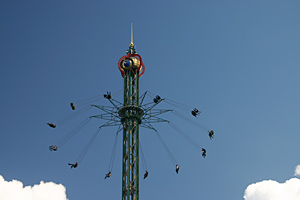
![]() During the summer, Tivoli typically opens at 11 a.m. and closes at
midnight (later on weekends). Most of the entertainment -- concerts,
Tivoli pantomime performances, etc. -- are held at night. Once you know
your travel dates, you can check for more specifics about entertainment on
Tivoli's
Web site.
During the summer, Tivoli typically opens at 11 a.m. and closes at
midnight (later on weekends). Most of the entertainment -- concerts,
Tivoli pantomime performances, etc. -- are held at night. Once you know
your travel dates, you can check for more specifics about entertainment on
Tivoli's
Web site.
![]() Tickets cost 85 Danish Kroner for adults, about $18 U.S. or 9.5 GBP at
press time; check
for the most recent currency exchange information. Kids under 12 get in
for about half that. This price includes entrance for a full day and night
and admission to regular entertainment, such as the pantomime or various
music performances (but not special concerts).
Tickets cost 85 Danish Kroner for adults, about $18 U.S. or 9.5 GBP at
press time; check
for the most recent currency exchange information. Kids under 12 get in
for about half that. This price includes entrance for a full day and night
and admission to regular entertainment, such as the pantomime or various
music performances (but not special concerts).
![]() What is not included? Rides require between one and four tickets
(about $2.25 apiece). Also a la carte are meals, symphonic performances in
the Tivoli Concert Hall Copenhagen, arcades and gambling.
What is not included? Rides require between one and four tickets
(about $2.25 apiece). Also a la carte are meals, symphonic performances in
the Tivoli Concert Hall Copenhagen, arcades and gambling.
![]() Cruise lines calling in Copenhagen on a daily visit will offer tours to
Tivoli that basically include transportation (a motorcoach shuttle) and
the basic admission fee (Celebrity's
is priced at $20 per person, for example; Holland
America charges $29). But Tivoli is fairly easy to reach
independently, and is a pleasant walk from downtown. From the ship's dock,
it's a 10-minute taxi ride (and taxis are plentiful to return you to the
pier).
Cruise lines calling in Copenhagen on a daily visit will offer tours to
Tivoli that basically include transportation (a motorcoach shuttle) and
the basic admission fee (Celebrity's
is priced at $20 per person, for example; Holland
America charges $29). But Tivoli is fairly easy to reach
independently, and is a pleasant walk from downtown. From the ship's dock,
it's a 10-minute taxi ride (and taxis are plentiful to return you to the
pier).
As a result of spending a day, a night, and then another day (I'm
mesmerized), plus a return visit in summer 2008 in Tivoli Gardens, here
are 10 reasons why you simply must visit.
1. Feel Like A Kid Again
One of the first things you'll see when you enter the park is the historic, 19th-century Pantomime Theater, whimsically decorated in an Oriental style (when the park was designed, Oriental themes were wildly popular in Copenhagen). You'll walk down sandy pathways toward funky fountains (in one there's a bubbling water-in-tubes display) and lush gardens of wild roses along with much flora and fauna. There are twinkling lights (even during the day) and sidewalk cafes -- and puppeteers performing and dancers twirling. I suddenly felt as free and deliriously energetic as I had at the age of 6 -- and all before I even got to the arcade and amusement park rides!
2.Tivoli's Location
Despite its lofty reputation and central location, you could walk by the outside of the park and never know this it's there! I'll grant that it doesn't look too enticing from the outside, surrounded as it is by urban mini-skyscrapers of sorts and stubby hotels (not to mention the quite unromantic Hard Rock Café, which sits on a corner of the property). But don't let that dissuade you. And once you walk through the gates -- you're transported to another world.
3. The Demon and Other Rides
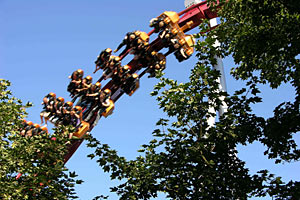 The park may be historic – and indeed features rides, like the
merry-go-round, that are odes to tradition – but the Demon (Daemonen in
Danish) is purely contemporary. Let's put it this way: Speeds register as
fast as 80 kilometers as the cars shoot through three loops on a Denmark's
highest full-circuit roller coaster. It's floorless so there is no brace
for your feet. And you will be flipped upside down at least twice.
Intrigued? It's not the only ride (and we paraphrase from Tivoli's Web
site) that "will turn you upside down, throw you around, or drop you
from a great height." Thrill seekers should also check out The Golden
Tower (Det Gyldne Tarn); it's 63 meters high and exerts minus 1G-force as
it descends from the golden cupola at the top to the ground below (and
then rises again, in a series of bungee jumping-like moves).
The park may be historic – and indeed features rides, like the
merry-go-round, that are odes to tradition – but the Demon (Daemonen in
Danish) is purely contemporary. Let's put it this way: Speeds register as
fast as 80 kilometers as the cars shoot through three loops on a Denmark's
highest full-circuit roller coaster. It's floorless so there is no brace
for your feet. And you will be flipped upside down at least twice.
Intrigued? It's not the only ride (and we paraphrase from Tivoli's Web
site) that "will turn you upside down, throw you around, or drop you
from a great height." Thrill seekers should also check out The Golden
Tower (Det Gyldne Tarn); it's 63 meters high and exerts minus 1G-force as
it descends from the golden cupola at the top to the ground below (and
then rises again, in a series of bungee jumping-like moves).Most of the people who got off after a ride on Dragon (Dragen), which swings you vertically, horizontally and flips you upside down, seemed exhilarated by the experience -- but a couple of women collapsed into the arms of friends, weeping in terror. Consider yourself warned.
For young kids, there are plenty of options as well; the Nautilus, new in 2008, is a virtual reality ride that takes travelers below sea level; there's also a classic Ferris wheel, dragon boats and more. And the park has even maintained its traditional roller coaster, a wooden ride that requires workers to sit in the last car to actively brake when it goes too fast.
7. Illuminations
At night, with all lit up, the park is at its most magical -- and if you can keep eyes prised until midnight, there's an evening fireworks display.
The Tivoli Concert Hall is the hub of the park's cultural scene and offers a huge range of options, depending on the timing of your visit (try to secure tickets in advance). In 2008, it served as a summer home to the New York City Ballet, hosted the annual international piano competition, welcomed soloists ranging from vocalists to pianists, and offered chamber music concerts.
The structure itself, built in 1956, is oddly gaudy from the front, with varied-colored panels. It's a strange look but you can't miss it! A refurbishment in 2005 incorporated an aquarium into a new foyer; to tour it requires a separate fee (and you don't have to stay for a concert!).
9. Shopping
While by no means would we suggest bypassing Stroget, Stockholm s mercantile hubbub, to browse at Tivoli, there are still some nice boutiques at the park selling touristy but fun souvenirs, like Scandinavian giftware and teddy bears. However, one boutique that is simply not to be missed is Illums Bolighus. The Denmark design chain (it has bigger stores in other locations in Copenhagen) offers representative wares from all the fantastic Scandinavian and Nordic designers, including Finland's Iittala, Sweden's Orrefors, Denmark's Minima -- and many more!
10. Christmas Market
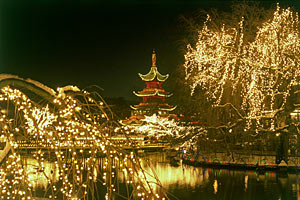 Though Tivoli
is best known as a summer playground, it's also open at Christmastime, and
is even more festive during December. It's ablaze in lights all day,
seasonal decorations abound and a full-fledged Christmas market sells all
manner of tchotchkes. Interestingly, in the past few years, cruise lines
like the U.K.'s P&O
and Cunard have been
offering a handful of seasonal cruises to Scandinavian market cities in
December.
Though Tivoli
is best known as a summer playground, it's also open at Christmastime, and
is even more festive during December. It's ablaze in lights all day,
seasonal decorations abound and a full-fledged Christmas market sells all
manner of tchotchkes. Interestingly, in the past few years, cruise lines
like the U.K.'s P&O
and Cunard have been
offering a handful of seasonal cruises to Scandinavian market cities in
December.Ultimately, we're not saying that you should bypass Copenhagen's fine historic attractions to while away the day at Tivoli (or are we?) -- it's just that I can't think of a more delightful way to spend a day or evening.
And here's a tip: If you are embarking or debarking your cruise in Copenhagen, it's a great place to pass a few quiet hours (the city's central rail station, which not only has a quick train to the airport but also will store luggage for a fee, happens to be right across the street!).
What do you love best about Tivoli? Or, if you haven't been, why can't you wait to go? Tell me at editor@smilingglobe.com.
The short story about Tivoli Copenhagen Denmark
From the very start, Tivoli included a variety of attractions: buildings
in the exotic style of an imaginary Orient: a theatre, band stands,
restaurants and cafés, flower gardens, and mechanical amusement rides
such as a merry-go-round and a primitive scenic railway. After dark,
colored lamps illuminated the gardens. On certain evenings, specially
designed fireworks could be seen reflected in Tivoli's lake.
Composer Hans Christian Lumbye (b. 1810 - d. 1874) was Tivoli 's musical director from 1843 to 1872. Lumbye was inspired by Viennese waltz composers like the Strauss family (Johann Strauss I and his sons), and became known as the "Strauss of the North." Many of his compositions are specifically inspired by the Tivoli gardens, including "Salute to the Ticket Holders of Tivoli , "Carnival Joys" and "A Festive Night at Tivoli ". The Tivoli Symphony Orchestra still performs many of his works.
In 1874, Chinese style Pantomimeteatret (The Tivoli Pantomime Theatre) took the place of an older smaller theater. The audience stands in the open, the stage being inside the building. The Tivoli theatre's "curtain" is a mechanical peacock's tail. From the very beginning, the Theater was the home of Italian pantomimes, introduced in Denmark by the Italian Giuseppe Casorti. This tradition, which is dependent on the Italian Commedia dell'Arte has been kept alive, including the characters Cassander (the old father), Columbine (his beautiful daughter), Harlequin (her lover), and, especially popular with the youngest spectators, the stupid servant Pierrot. The absence of spoken dialogue is an advantage, as Tivoli is now an international tourist attraction.
In 1943, Nazi sympathizers attempted to break the Danish people's spirit by burning many of Tivoli's buildings, including the concert hall, to the ground. Undaunted, the Danes built temporary buildings, and the park was back in operation after a few weeks.
Tivoli is always evolving without abandoning its original charm or traditions. As Georg Carstensen said in 1844, "Tivoli will never, so to speak, be finished," a sentiment echoed just over a century later when Walt Disney said of his own Tivoli-inspired theme park, "Disneyland will never be finished as long as there is imagination left in the world."
Political forces
Denmark has a multi-party system and no single
party has held an absolute majority in parliament since the beginning of
the 20th century.
The degree of transparency and accountability is reflected in the
public’s high level of satisfaction with the political institutions,
while Denmark is also regularly considered one of the least corrupt
countries in the world by international organizations
On many issues the political parties tend to opt in for a co-operation,
and the Danish state welfare model receives a broad parliamentary
support. This ensures a focus on public-sector efficiency as well as
devolved responsibilities of local government on regional and municipal
levels.
Denmark is the oldest kingdom in the world
Monarchy
 Queen
Margrethe II (Margrethe Alexandrine Þórhildur Ingrid), born 16 April
1940, is since 14 January 1972 Queen Regnant and head of state.
Queen
Margrethe II (Margrethe Alexandrine Þórhildur Ingrid), born 16 April
1940, is since 14 January 1972 Queen Regnant and head of state.
In accordance with the Danish Constitution the Danish Monarch, as head
of state, is the theoretical source of all executive, judicial and
legislative power. However, since the introduction of parliamentary
sovereignty in 1901 a de facto separation of powers has been in effect.
The text of the Danish constitution dates back to 1849. Therefore it has
been interpreted by jurists to suit modern conditions. In a formal
sense, the Monarch retains the ability to deny giving a bill royal
assent. In order for at bill to become law, a royal signature, as well
as a countersignature by a government minister, is required. The Monarch
also chooses and dismisses the Prime Minister, although in modern times
this has become a no-option. Today a dismissal would cause a
constitutional crisis. King Christian X was the last Monarch to exercise
the power of dismissal, which he did on March 28, 1920 sparking the 1920
Easter Crisis. All royal powers called Royal Prerogative, such as
patronage to appoint ministers and the ability to declare war and make
peace, are exercised by the Prime Minister and the Cabinet, with the
formal consent of the Queen. When a new government is to be formed, the
Monarch calls the party leaders to a conference of deliberation, where
the latter advise the Monarch. On the basis of the advice the Monarch
then appoints the party leader who commands a majority of recommendation
to lead negogiations for forming a new government.
According to the principles of constitutional monarcy, today the Monarch
has an essentially ceremonial role, restricted in his or her 
The Royal Reception Rooms

The Royal Reception Rooms are used for official functions of the Royal
Family such as New Year Levee, reception of ambassadors or gala
banquets. The Reception Rooms are richly adorned with works of art
rescued from the two earlier palaces as well as decorations by some of
the best Danish artists from the early 20th century.
Audience Chamber and Council Room
To visit the Royal Reception Rooms
you enter Dronningeporten (Queen s Gate) and go through Drabantsalen (Guards Room). From there you go to Kongetrappen (King s Stairway). At the foot of the stairs are Audiensgemakket (Audience Chamber) and Statsrådssalen (Council Room). The Queen holds an audience every other Monday and attends Council with the government as required. The Queen in Council signs the new laws after they have been agreed upon by the Parliament. The Audience Chamber and the Council Room are the only Royal Reception Rooms that are closed to the public.
Tower Room and Throne Room
The King s Stairway gives access to Tårnsalen
(Tower Room). The Tower Room displays a series of tapestries with motifs
from Danish 
Visit Great Hall
The Great Hall is the largest and most
spectacular of the Royal Reception Rooms. The Hall is 40 metres long
with a ceiling height of 10 metres, and a gallery runs all the way
around the room. The Great Hall was renovated on the occasion of Queen
Margrethe s 60th birthday when artist Bjørn Nørgaard s 17 tapestries
recounting the history of Denmark were hung on the walls. The tapestries
were a gift from the Danish business community for Queen Margrethe s
50th birthday.

The Prime Minister uses the Royal Reception Rooms as well, particularly
in connection with state visits. On such occasions the official banquet
is often held in Alexandersalen (Alexander Room). The Alexander Room is
decorated with Bertel Thorvaldsen s marble frieze "Alexander the
Great Enters Babylon". The frieze was made for the second
Christiansborg Palace, and parts of it survived the fire. It was later
restored and mounted in this room.
Visit The Church of the Danish Royal Family
Christiansborg Palace Chapel as we know it
today was inaugurated by a commemoration service on Whit Sunday 14 May
1826 to celebrate the 1000 anniversary of the introduction of
Christianity to Denmark. From this point in time, the Palace Chapel
served as the 
One of the first major religious ceremonies to take place in C.F. Hansen’s church was the wedding of Prince Frederik, later to become Frederik VII, and Princess Vilhelmine, the daughter of Frederik VI. The wedding took place on 1 November 1828 and was followed by a banquet at the Palace for more than 700 guests. On the occasion of the wedding, the Royal Family started using the newly rebuilt second Christiansborg by staying there for a few days. The second Christiansborg was never fully completed, and the Royal Family used it only seldom.
However, over the years the Palace Chapel has provided the setting for several weddings and other important ceremonies in the history of the Royal Family. In 1878, Princess Thyra, the daughter of Christian IX, married the Duke of Cumberland in the Palace Chapel. In 1892, Christian IX and Queen Louise celebrated their golden wedding with a ceremony in the Palace Chapel, and in 1897 the Palace Chapel provided the setting for the wedding of Princess Ingeborg, the daughter of Frederik VIII, and Prince Carl of Sweden.

